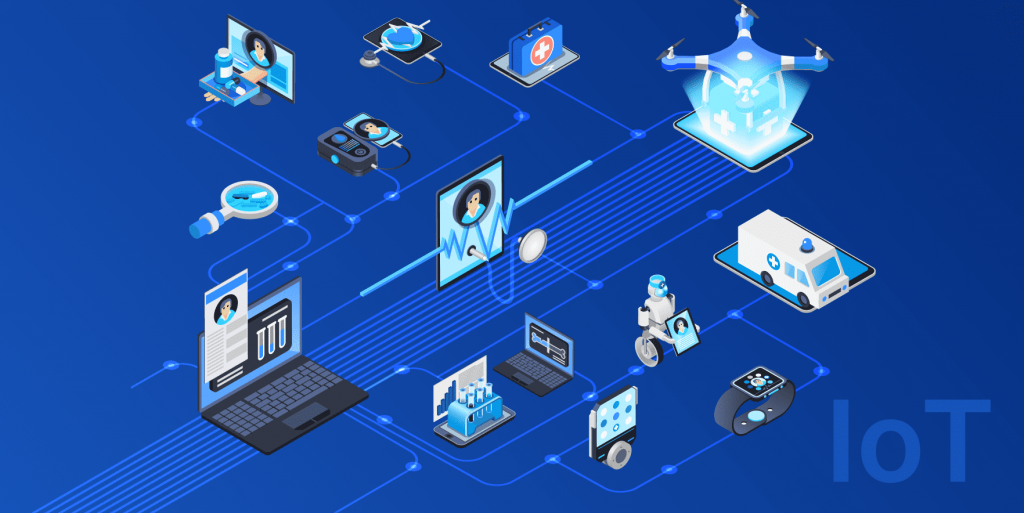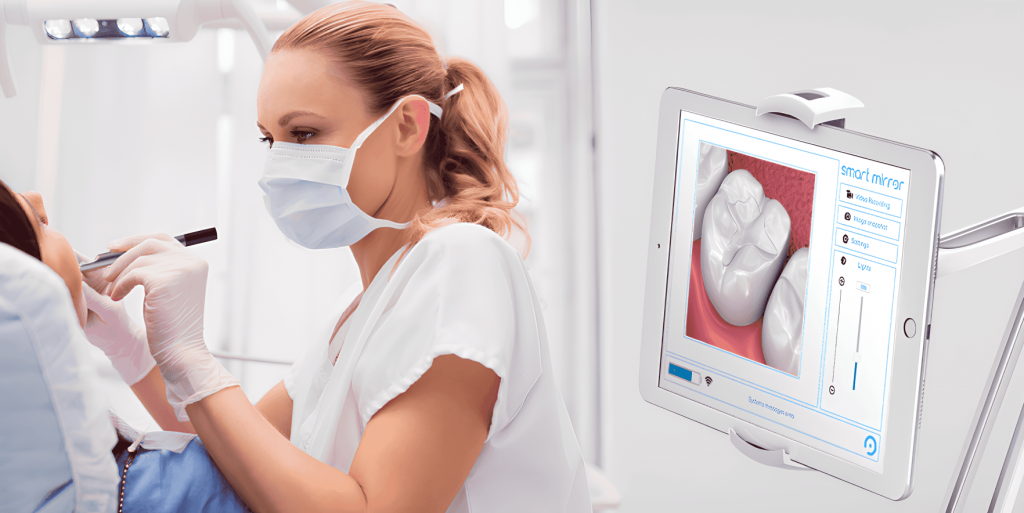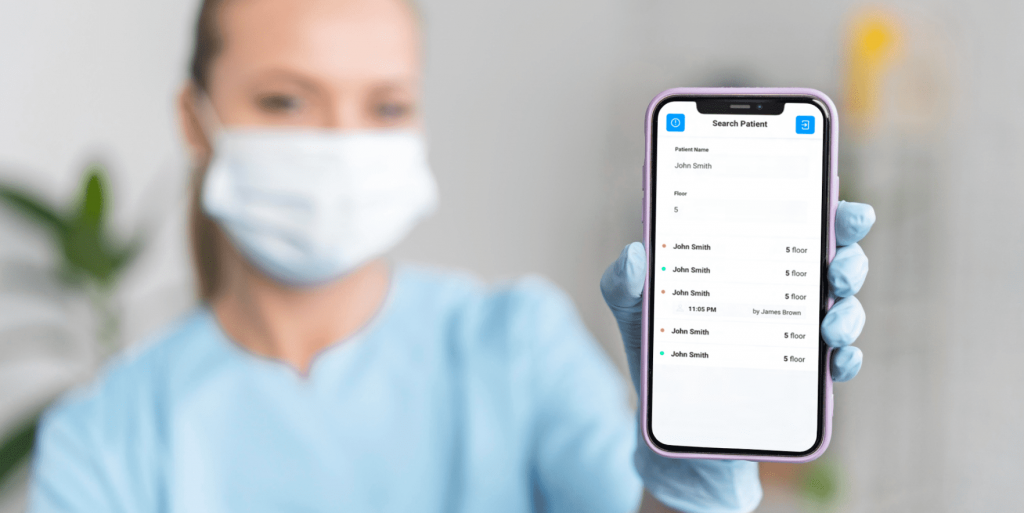Table of Contents
The impact of IoT on advancing and improving patient care and operational efficiency in the medical field is unquestionable. The most active implementation of these technologies began during the COVID-19 pandemic and has only been growing since. According to Statista, the IoT healthcare market is growing at an annual rate of 9.91%, and by the end of 2026, the total value is expected to reach 103.90 billion US dollars.
In this article, we will explore today’s applications of IoT in healthcare using project examples from our company and discuss the benefits and drawbacks of these technologies.

An overview of IoT in healthcare
The Internet of Things in healthcare, also known as medical IoT, refers to the network of interconnected devices that communicate and share data to monitor, diagnose, and treat patients. These devices range from wearable health monitors to sophisticated medical equipment in hospitals. The healthcare industry has been progressively integrating IoT technologies to address numerous challenges, such as:
- Monitoring the health of patients with chronic diseases (diabetes, heart conditions, etc.) without the need to visit the clinic frequently;
- Shortening the time spent in hospitals and preventing readmissions;
- Detecting cancer at early stages and further monitoring for subtle changes;
- Conducting more advanced medical examinations.
For example, remote patient monitoring systems have become a standard practice, especially in managing chronic diseases. Doctors can access all the crucial information about their patients at any time using applications on their smartphones. Furthermore, getting an appointment through a digital app instead of calling and waiting in line saves patients a lot of time and nerves.
Importance of IoT in healthcare
The implementation of IoT connectivity in healthcare rapidly reshapes the industry, enhancing patient care and operational efficiency. Its vast applications benefit not only patients and their families but also hospitals and insurance companies.
IoT for patients
Wearable devices such as fitness bands, smartwatches, and other connected devices provide patients with access to their health data (like blood pressure, heart rate, glucose level, etc.) so that they can proactively manage their health. Not to mention these devices can also remind patients to take their medications, schedule appointments, or even perform specific health-related tasks.
By providing real-time feedback and alerts, wearable devices empower users to make informed decisions about their well-being. For elderly people living alone and for their families, this feature is very important. Devices can be set to send alerts if there is a sudden change in the patient’s condition. This helps family members and medical professionals respond quickly to any issues.
IoT for physicians
Physicians are leveraging IoT to enhance patient care and streamline workflows. Remote patient monitoring systems enable doctors to receive real-time data on their patients’ conditions, allowing for timely interventions. It also helps to create personalized treatment plans based on accurate data rather than relying solely on patient self-reporting.
IoT for hospitals
Hospitals are leveraging IoT to enhance operational efficiency and improve patient outcomes. Smart hospital systems with integrated IoT technology can track equipment usage, monitor patient flow, and manage inventory in real time. For instance, RFID tags can be used to locate medical devices, ensuring that critical equipment is always available when needed.
Moreover, IoT solutions can enhance communication between departments, reducing errors and improving care coordination. Patient rooms equipped with smart sensors can monitor environmental conditions, ensuring comfort and safety, which directly impacts the recovery process.
IoT for health insurance companies
Health insurance companies use IoT solutions for healthcare to gain valuable insights into patient behavior and health trends. By analyzing data collected from wearable devices and mobile health apps, insurers can develop personalized health plans and wellness programs.
Moreover, they can use this data to spot suspicious patterns and identify potentially fraudulent claims. Therefore, IoT devices promote transparency between insurers and customers in pricing, claims handling, and risk assessment processes, fostering trust and providing assurance for both parties.
Key Internet of Things healthcare applications
As we talked about the advantages of IoT in healthcare, let’s take a closer look at what exactly it brings to the table.
Remote patient monitoring
Remote patient monitoring (RPM) employs IoT devices to collect and transmit patient data in real time, enabling healthcare providers to track health conditions without the need for in-person visits. This is particularly beneficial for:
- Heart-rate monitoring: IoT devices can continuously measure and transmit heart rate data, helping to manage conditions such as arrhythmias, heart failure, or hypertension. This allows for quick detection of irregularities and timely medical intervention.
- Glucose monitoring: For patients with diabetes, continuous glucose monitors (CGMs) can provide real-time readings of blood sugar levels. This helps manage insulin therapy, adjust dietary plans, and prevent both hyperglycemia and hypoglycemia.
- Depression or mood monitoring: Wearable devices and mobile apps can track physiological indicators related to mood and mental health. By monitoring changes in activity levels, sleep patterns, and other relevant data, healthcare providers can better assess and manage conditions like depression or anxiety.
- Parkinson’s disease monitoring: IoT devices can track motor symptoms such as tremors, rigidity, and gait disturbances in patients with Parkinson’s disease. Continuous monitoring enables healthcare providers to adjust treatment plans and medications more effectively, improving patient outcomes and their quality of life.
According to the study referred to in Medical Economics, during the 30-day experiment, RPM reduced hospital readmissions for patients with heart conditions by 50%. And that’s only some of the examples.
Smart medical devices
Smart medical devices equipped with IoT capabilities are transforming diagnostics and treatment. Internet of Things medical devices gather and transmit data for analysis, improving accuracy and efficiency in healthcare delivery. We’ve mentioned some of the devices for RPM above, but there are a lot more. Some of the said devices help with surgeries and other medical procedures — for example, ingestible sensors and connected contact lenses.
Ingestible sensors
Ingestible sensors are a ground-breaking development in the realm of smart medical devices. These tiny sensors, often embedded in medication capsules, allow for the monitoring of internal health conditions by transmitting data about the patient’s gastrointestinal tract without invasive procedures. They can measure things like stomach PH levels or find the source of internal bleeding.
Connected contact lenses
Smart contact lenses represent another frontier of IoT in the medical field. These innovative lenses can monitor various health indicators, including glucose levels for diabetic patients, while also correcting vision. Additionally, they can be used to deliver medication to the eye, such as for treating allergies, glaucoma, or corneal injuries.
The latest advancements in smart lenses, patented by Google, include a micro camera that is controlled by blinking. This feature allows patients to take photos with their eyes and then process the captured data.
Clinical operations and workflow management
One of the most critical applications of IoT in healthcare is in clinical operations and workflow management. IoT devices can automate numerous administrative tasks, from patient check-ins to appointment scheduling, thereby reducing the burden on healthcare staff. For example, smart sensors can track patient flow within a facility, providing real-time data that helps staff allocate resources effectively.
Robotic surgery
Robotic surgery is one of the most advanced applications of IoT in healthcare. Some of the medical procedures are difficult to manage with human hands. Small IoT devices can help with the task. Surgical robots, equipped with IoT technology, enable surgeons to perform complex procedures with greater precision and control. Many robotic surgeries are minimally invasive, meaning they involve smaller cuts compared to traditional open surgery. This typically results in shorter recovery times, less pain, and minimal scarring. Moreover, robotic systems often include high-definition cameras that give surgeons a magnified, detailed view of the surgical area, improving accuracy.
The IoT has also transformed the training of surgical professionals. Surgeons can use virtual reality (VR) and augmented reality (AR) technologies integrated with IoT systems to practice procedures in a risk-free environment. Moreover, IoT enables remote collaboration among surgical teams, allowing experts to assist in surgeries from anywhere in the world, thereby enhancing the expertise available during complex procedures.
Challenges and risks
Alongside all the benefits and possibilities that the Internet of Things in healthcare brings, there are also certain risks and challenges that you need to be aware of.
Data security and privacy
The large amount of data produced by IoT devices creates major security and privacy concerns.
- Data breaches: Healthcare data is a prime target for cyberattacks. It’s crucial to make sure that IoT devices and the data they gather are secure. The impact of the breaches can be significant. It not only leads to financial loss but also harms the reputation and causes patients to lose trust.
- Compliance: Healthcare organizations must comply with regulations such as HIPAA, which mandates the protection of patient information. Implementing IoT solutions while maintaining compliance can be challenging. Additionally, international regulations may vary, complicating the deployment of IoT solutions across different regions.
Integration with existing systems
Integrating IoT technologies into existing healthcare infrastructures also presents several challenges. Many healthcare providers rely on legacy systems that are not designed to communicate with modern IoT devices. This leads to compatibility issues, data silos, and inefficiencies.
Moreover, the diversity of devices and platforms used in healthcare complicates the integration process. For example, a hospital may utilize various IoT devices for monitoring patients, each requiring different protocols and standards for data exchange. Without a unified approach to integration, healthcare organizations may struggle to gain a comprehensive view of patient data, ultimately hindering the potential benefits of IoT applications.
Cost and infrastructure
Implementing IoT solutions in healthcare requires significant investment in technology and infrastructure.
- Upfront costs: The initial costs of IoT devices, software, and infrastructure can be prohibitive for some healthcare providers.
- Maintenance: Ongoing maintenance and updates of IoT systems are necessary to ensure their reliability and security, which can be quite pricey as well.
Examples of healthcare IoT solutions from SoftTeco
As SoftTeco has extensive experience working with healthcare providers, we have successfully developed various IoT solutions. Here are a few of our projects that clearly demonstrate the benefits of IoT technology in healthcare.
Smart Mirror
One of our notable IoT projects is Smart Mirror.

Smart Mirror is an advanced dental mirror with LED lighting that simplifies dentists’ work and enhances patient experience with video streaming capabilities. Our client requested us to develop a mobile application that would connect with the device. However, at the moment the dental mirror was still under development and our team worked with a simulator instead of a real device.
As a result, we successfully developed a SmartMirror mobile app that connects to the smart mirror dental device through Wi-Fi, receives the transmitted data, and displays it in video format. The app lets dentists adjust the mirror’s lighting intensity and type and manage the tool as needed. It streams real-time video, captures photos, and records videos for sharing with patients or storing in the database. The app also supports data sharing via QR codes, monitors battery life, and allows firmware updates.
VisitorAccess

During the COVID-19 pandemic, we joined other software development companies in taking action against the virus. Therefore, we developed several free IT solutions to help medical organizations and patients prevent the spread of the disease and monitor symptoms. One of such solutions is VisitorAccess.
SoftTeco, in collaboration with Kandasoft, developed a user-friendly, HIPAA-compliant solution that is easily scalable for any medical facility. Its main goal is to prevent disease spread by quickly identifying symptoms among individuals entering the facility. The system assesses their health in real time and keeps records of all interactions.
To summarize
There is no way to deny the importance of IoT in healthcare. These devices enable real-time monitoring and data collection, enhancing the ability to diagnose, treat, and manage patients more effectively. IoT solutions make healthcare more accessible and responsive to individual needs. And as technology continues to evolve, paving the way for further innovations, SoftTeco stands ready to assist in creating cutting-edge solutions tailored to the healthcare sector.


Comments